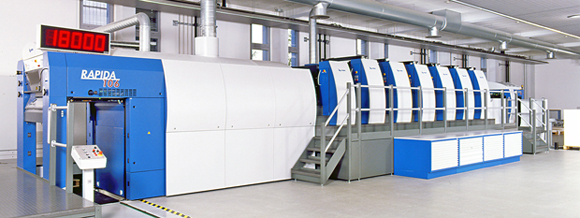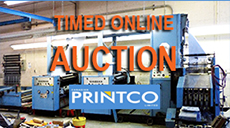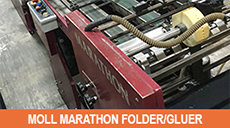|
Untruths often metastasize into reality all
around us. Politics arguably provides
the most consistent train of falsehoods
becoming dogma, or perhaps it is the religious
zealots of all faiths who polarize followers
into believing we’re right, you’re
wrong. The world of print too is not immune
from basing opinions on guttural assumptions,
particularly when it comes to
advances in press technology.
This is an environment created by all of
today’s press makers, as they compete for
tightening market share with highly advanced
offset press lines and associated
workflow. For the past
decade, printers have watched offset-
press innovation – often not
fully appreciated, because of the
marketing dollars and future interests
poured into toner and
inkjet platforms – redefine traditional
run-length boundaries.

Today, offset press makers are
also leveraging significant
sheetfed advances, in particular, to
redefine application boundaries.
Their main target is the packaging
sector, more specifically longerrun
carton production, which is
traditionally a field ruled by largeformat
sheeted presses. KBA continues
to lead this
sector and has controlled
a 50 percent
market share, globally,
in large-format offset
for well over a decade.
In 2012 alone, KBA
held more than a 65
percent market share
in North America’s
large-format sheetfed
sector.
It came as no great
surprise during a recent
conversation that
a printer suggested,
“There is only one
company that makes a
packaging press.” Most every production or
operations manager holds strong opinions
about the offset machines they run,
whether it is the result of a close – often historic
– relationship with their press salesperson
or mechanic, or just a general
likability of the press architecture itself.
There are a myriad of reasons why pressrooms
becomes entrenched in machine
brands and their perceived positions in the
market.
These historic positions, however, once
so clearly defined in the printing world by
application and run-length, and therefore
press format size, are shifting more than
ever. Large-format sheetfed will continue
to dominate high-volume packaging for
years to come, but today’s innovations in
sheetfed – not to mention recent advances
in toner and inkjet technologies – mean almost
any modern press format size can impact
packaging, which was certainly the
case with several modern 40-inch sheetfed
presses recently introduced around drupa.
In fact, any press printing to 1 mm (0.40
inches), which has skeletal transfer cylinders,
double-size impression cylinders, air in
transfers, and carton-attachment options
like receding non-stop deliveries, large diameter
in-feeds, press up-lifting features or
UV capabilities, can be considered a packaging
press. All five of the world’s major
press makers can deliver such machines
today within a very close measure of competence
– depending, of course, on which
features a printing company values most.
Okay – not every
press maker builds machines
with stock transfers
exceeding 1 mm,
but it is of little consequence
for 95 percent of all packaging applications
anyway. Even the most
experienced press operators tend to ignore
this fact because they are so deeply rooted
in tradition and cannot see the forest for
the trees, which became crystal clear on my
recent visit to a high-end cosmetics printer.
These types of plants – where double
hits, overprint varnishes and unique combinations
of inks and coatings are part of a
press operator’s everyday life – are always
pushing the print-production envelope.
This particular cosmetics printer had just
bought a new press that would soon arrive.
I was there to inspect a used press on its
way out the door and so I asked the lead
pressman for his thoughts about the older
machine.
“It isn’t a board press,” he replied. “We
need a board machine here, not a paper
press.”
I just had to shake my head – double-size
cylinders, 40-point capacity and skeletal
transfers – bingo! – This is a board press.

Unexpected surprises in the laboratory
During the late-1960s to 1990s, Planeta
was long the most-common sight in the
world’s packaging plants. The press maker
became an unexpected carton favorite
when printers discovered
that, particularly following
the launch of its Variant series
in 1965, how good they
were at running thick materials
(in sizes from 4 to 8).
Based in Soviet controlled
East Germany, with a cash strapped Deutsche Demokratische Republik
(DDR) government, Planeta needed
western hard currency and sold presses to
the market at prices significantly lower
than their real value.
Big double-size cylinders were unheard
of at the time and it even became possible
to use these innovative presses for printing
on micro-flute (F-flute up to 1.8 mm). Despite
struggling with poor Robotron
electrics and associated quality-control issues,
the Planeta design still presented an
enormous advancement over all other
competitors – even if it took a while to impart
the true potential of these presses to
the marketplace.
Prior to 1965, Planeta, an old established
builder, did not really find its sales imprint until
after the war when the old English designed
Mann Fast Five was duplicated and
sold as a PZO and PVO series press. This
design did not have any inherent positives
for running carton. The Variant changed all
that.
Harris, meanwhile, a US-based press
maker from yesteryear, did have a unitized
press with double-size transfer cylinders,
but also single-size impressions. Nonetheless,
Harris was able to run board on all its
presses, especially in the 60-inch and
77/78-inch formats. The same held true
for the American-built Miehle machines.
During this period, Roland, Harris,
Miehle, Crabtree and Nebiolo were the
prime competitors to Planeta in most of
the +3b sizes.
These historic companies over time were
either absorbed or decimated by today’s
modern press makers. Planeta was scooped
up König & Bauer,
known today as KBA.
Before purchasing
Planeta, KBA was focused
as a web-offset
manufacturer and
beginning to make its
mark with finely
tuned Intaglio machines
for currency
production.
KBA also had a very popular stable of letterpress machines, as well as a range of smaller sheetfeds like the KRO and SRO, but these were mostly 72-cm (28-inch) machines. Early experiments with the 3b format brought out an array of odds and sods, one press in particular drew upon the Heidelberg Rotaspeed ’s mirror image platform. KBA then introduced a unitized RA 104 press in the 1980s. The purchase of Planeta provided the company with the market to advance its development of the 104, and subsequent larger sizes, into a respected worldwide sheetfed line.
Today, KBA’s RA142 (now RA145) and especially the RA 162a have done exceedingly well in carton shops, building on years of expertise that began with the Variant series. manroland, with its past link to Roland Ultra and 800, has also enjoyed historically significant placement in carton shops when it comes to large-format sheetfed.

The KBA Rapida 106-CX
is the high specification press for paper and carton. Incorporates features from the 105 and 105U. Same cylinder arrangement
as Komori, Heidelberg and Roland, Can offer press with “CX” package to increase range of materials..
|











